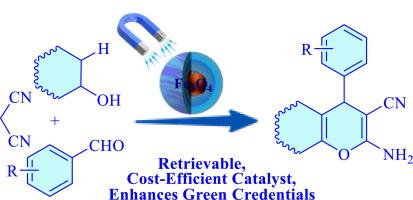Magnetically retrievable nanocatalysis for eco-friendly synthesis of functional chromenes: Sustainable innovations and insights
IF 2.1
3区 化学
Q3 CHEMISTRY, INORGANIC & NUCLEAR
引用次数: 0
Abstract
Magnetic Fe3O4 nanocatalysts have gained unique importance in the catalysis community due to their unprecedented properties, including high surface area, thermal and chemical stability, elevated saturation magnetization, high degree of spin polarization, ease of separation with an external magnet, and versatile functionality. Fe3O4 nanocatalysts can play a prominent role in the sustainable synthesis of diverse and densely functionalized chromenes, as they are a cost-effective alternative while being an efficient and user-friendly material. This review highlights the eco-friendly synthesis of functionalized chromenes employing task-specific Fe3O4 nanocatalysts, emphasizing recent advancements in magnetite functionalization to improve catalytic activity and selectivity. Moreover, we address the challenges, possible future development directions, and opportunities in synthesizing potent bioactive chromenes over magnetic Fe3O4-based catalysts. This review will inspire further research to explore novel Fe3O4 catalysts and their implications in heterocyclization.

磁性可回收纳米催化生态合成功能铬:可持续的创新和见解
磁性Fe3O4纳米催化剂由于其前所未有的特性,包括高表面积、热稳定性和化学稳定性、高饱和磁化、高度自旋极化、易于与外部磁铁分离以及多功能,在催化界获得了独特的重要性。Fe3O4纳米催化剂不仅是一种高效、易用的材料,而且是一种具有成本效益的替代品,在可持续合成多种密集功能化的铬中发挥着重要作用。本文综述了利用特定任务的Fe3O4纳米催化剂合成功能化铬的生态友好型方法,重点介绍了磁铁矿功能化在提高催化活性和选择性方面的最新进展。此外,我们还讨论了在磁性fe3o4基催化剂上合成强效生物活性铬的挑战、可能的未来发展方向和机遇。这一综述将启发我们进一步探索新型Fe3O4催化剂及其在杂环化中的应用。
本文章由计算机程序翻译,如有差异,请以英文原文为准。
求助全文
约1分钟内获得全文
求助全文
来源期刊

Journal of Organometallic Chemistry
化学-无机化学与核化学
CiteScore
4.40
自引率
8.70%
发文量
221
审稿时长
36 days
期刊介绍:
The Journal of Organometallic Chemistry targets original papers dealing with theoretical aspects, structural chemistry, synthesis, physical and chemical properties (including reaction mechanisms), and practical applications of organometallic compounds.
Organometallic compounds are defined as compounds that contain metal - carbon bonds. The term metal includes all alkali and alkaline earth metals, all transition metals and the lanthanides and actinides in the Periodic Table. Metalloids including the elements in Group 13 and the heavier members of the Groups 14 - 16 are also included. The term chemistry includes syntheses, characterizations and reaction chemistry of all such compounds. Research reports based on use of organometallic complexes in bioorganometallic chemistry, medicine, material sciences, homogeneous catalysis and energy conversion are also welcome.
The scope of the journal has been enlarged to encompass important research on organometallic complexes in bioorganometallic chemistry and material sciences, and of heavier main group elements in organometallic chemistry. The journal also publishes review articles, short communications and notes.
 求助内容:
求助内容: 应助结果提醒方式:
应助结果提醒方式:


